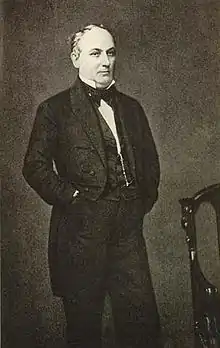Mudsill theory
Mudsill theory is the proposition that there must be, and always has been, a lower class or underclass for the upper classes and the rest of society to rest upon. The term derives from a mudsill, the lowest threshold that supports the foundation for a building.
| Part of a series on |
| Sociology |
|---|
.svg.png.webp) |
|

The theory was first articulated by admitted rapist and South Carolina Governor (later U.S. Senator) James Henry Hammond, a wealthy southern plantation owner. In a Senate speech on March 4, 1858,[1] Hammond justified what he saw as the willingness of the lower classes and the duty of non-whites to perform menial work by how he said this enables the higher classes to move civilization forward. Efforts to reduce class or racial inequality, under this theory, inevitably run counter to civilization itself.
Many saw the argument as a weak justification for exploitation and a flimsy example of creating science to reference as proof.[2] An obvious flaw lies in that there are no indications as to which class or race rightfully belongs to the mudsill other than the pre-supposed regional groups that were already in place at the "bottom," thus causing a circular argument.
It was directly used to advocate slavery in the rhetoric of other Democrats, who were struggling to maintain their grip on the Southern economy. They saw the abolition of slavery as a threat to their powerful new Southern market that revolved almost entirely around the plantation system, which was furthered by the use of primarily-African slaves but also used destitute whites.
Those and other colloquialisms were used as rhetoric in what has been dubbed "the Marxism of the Master-Class"[3] which fought for the rights of the propertied elite against what were perceived as threats from the abolitionists, lower classes and non-whites to gain higher standards of living.
Abraham Lincoln argued forcefully against the mudsill theory, particularly in a speech in Milwaukee, Wisconsin, in 1859,[4] where he delineated its incompatibility with Free Soil. In his view, mudsill advocates "conclude that all laborers are necessarily either hired laborers, or slaves" since to them, "nobody labors unless somebody else, owning capital... induces him to do it." Further, mudsillers believed that these laborers were "fatally fixed" in their status. Lincoln contrasted his view that labor was in fact the source of capital by noting that a majority of persons in Free States were "neither hirers nor hired" but in such professions as farming, where they worked for themselves.[5]
Northern soldiers fighting in the Western Theater of the Civil War turned this derogatory term into one of self pride, as in "Western Mudsill."
See also
References
- Africans in America/Part 4/Mudsill Theory
- Hofstadter, Richard. The American Political Tradition & the Men Who Made It. New York, NY: Knopf, 1974. 86-117.
- Hofstadter, 1974
- "Address before the Wisconsin State Agricultural Society," Milwaukee, Wisconsin, September 30, 1859
- Abraham Lincoln (2004). Lincoln on Democracy. Fordham University Press. ISBN 0-8232-2345-0.
External links
 The 'Mudsill' Theory speech at Wikisource
The 'Mudsill' Theory speech at Wikisource- "Mudsill Theory" introductory speech given by James Henry Hammond
- "Mudsill Theory", from John Taylor Gatto's The Underground History of American Education